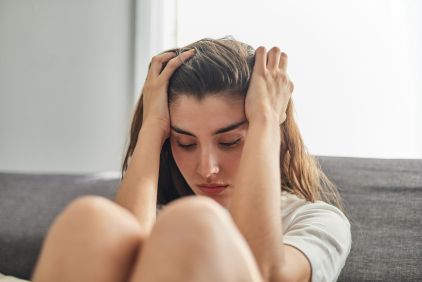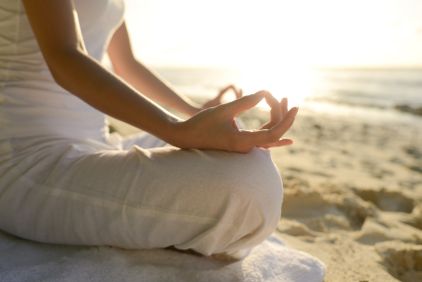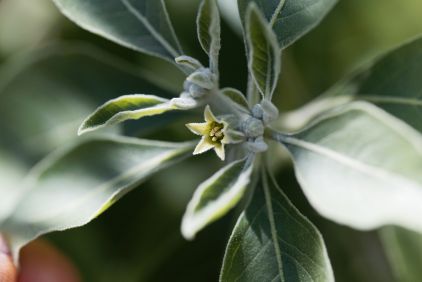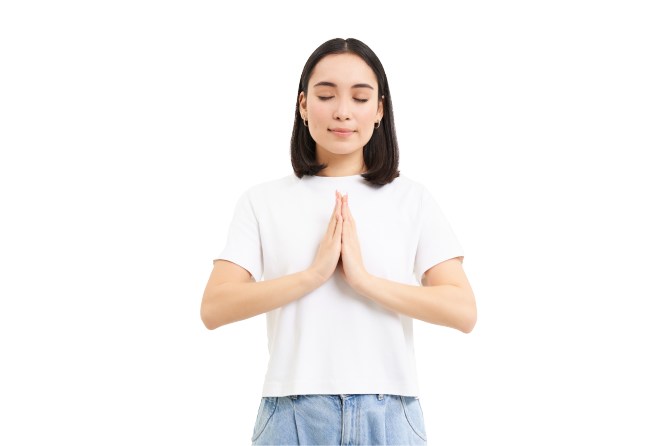Anxiety is that little ball in the stomach, that more or less conscious expectation of a danger or a problem to come. Everyone will be confronted with it at least once in their life and there is absolutely no need to worry... Except when this anxiety takes hold. It then starts to irradiate the body, sometimes to the point of causing stress, insomnia, heart palpitations or mood swings. The body and the mind join together in a spiral that is complicated to live. It is these two parts of ourselves that Ayurveda takes into consideration to propose a whole range of useful solutions to daily concerns, small or large...

We can admit it: we all know that period when a little worry is running around in our heads. At first it's a hunch, a bad feeling about something that will go wrong... And then this little worry settles in, it takes over. Sometimes it prevents us from eating or sleeping. Little by little it turns into a real demon that ruins our lives. It is this little demon that we call anxiety!
Of course, we all have a different degree of tolerance to anxiety. There is a world of difference between those who occasionally encounter the "little devil" and those who live completely under its yoke!
According to Ayurveda, our degree of resistance to anxiety is related to our constitution, that is to say to the ordinary state of the doshas balances. If the little devil is too present, it means that the doshas are not well balanced!
The subjects of anxiety vary according to the dominant doshas
→ Vata anxiety is the result of excessive nervous activity, too many thoughts and worries, or too abrupt changes.
→ Pitta anxiety usually stems from an unwillingness to let go. Pitta people want to control their lives and everything that happens to them. They get anxious when that control is diminished.
→ Kapha anxiety usually comes from the loss of possessions and attachments. It is the end of an era and Kapha anguishes over what might happen.
As you can see, if a dosha is in excess in your current constitution, you are more likely to develop its negative energy.
Even if the imbalance of one of the three doshas, whatever it is, can be responsible for our disorders, it is the Vata dosha, when it is exaggeratedly present in the organism, which causes anxiety, fear, confusion... Even to the point of having disproportionate reactions! It is therefore better to try to calm it down if you show these signs.
Soothe Vata, the anxiety dosha

Vata personalities would need regularity in their life and to maintain it, but this is difficult for these personalities eager for creativity, vitality and freedom!
Remember that anxiety can only be relieved with a certain routine: fixed meal times and constant activity. You will sleep better at night and your appetite will be whetted.
Beware, given the fantasy of a Vata personality, you may want to abandon this regularity once the energies are adjusted. However, in Ayurveda, it is always necessary to maintain the balance, so stay on the rhythm that led you to this well-being, even if you sometimes have to force yourself. If you have chosen to go to bed every night at 10:30 pm for example, you will have to continue this effort, even when you will have the impression that you do not need it anymore!
The "chemical" manifestation of anxiety
According to the latest scientific research, at the origin of the anxiety disorder, there would be a dysfunction of certain neurotransmitters. These small substances serve as messengers for nerve impulses so that neurons communicate with each other, ideally in a positive way to keep us in a good mood.
GABA (γ-aminobutyric acid) is one of them and it is the main inhibitor of all neuronal overreactions. You may not know it, but it is the one that moderates our behavior. Although there are also those that are more often talked about: noradrenaline, serotonin and cortisol (stress hormone).
Let's go back to GABA. It is the neurotransmitter of calm and recovery. In the hippocampus, where the memory area of the brain is located, GABA helps to control "dark thoughts", to avoid rehashing, which means that it has an essential function in anxiety disorders.
How do we supply GABA to our body?
GABA is naturally present in plants such as chestnuts, potatoes, rice, astragalus and certain teas, but it is primarily synthesized internally, in our bodies! To promote its production, we need to fill up on B vitamins, especially B6, green tea rich in L-theanine and spirulina, for example.
According to Ayurveda, Ashwagandha also has an action on GABA. This adaptogen plant calms the agitated spirits. Rich in active substances, it has many virtues. Thus, in addition to its action on anxiety, we can note that Ashwagandha stimulates the libido, awakens vitality and promotes sleep, hence its scientific name of Withania Somnifera. The fact that it is an adaptogen plant allows it to act on the body where it needs it most.
The ayurvedic plant of serenity
Another Indian plant acts effectively on the "chemical" manifestations of anxiety and in particular on neurotransmitters other than GABA...
Known since ever in India for its virtues on the brain, it is used in Ayurvedic medicine to awaken motivation, the desire to go to the end of things, in short this plant is a concentrate of joy of living.
The name of this plant is mucuna, also called Mucuna pruriens or musk pea. Mucuna works as simply as effectively in the body by stimulating dopamine. We normally produce this small molecule of happiness when we sleep, but for many organic reasons, we can sometimes lack it. This is the case, for example, for people with Parkinson's disease, according to many researchers. When we lack dopamine, our nervous system no longer receives messages and our behavior is altered.
According to a scientific study published in August 2017 in the journal Neurology, mucuna would be as effective as some drugs known to alleviate a dopamine deficiency!
Mental purity, a balance to find

In Ayurveda, mental purity is called Sattva: it is the point of absolute balance, when you feel relaxed, serene. Sattva needs calm, silence and space to renew itself. As one can imagine, this balance is exhausted in action, noise, agitation or great philosophical debates.
To understand this notion and to put it into perspective in our western society, you just have to imagine the differences between a Sunday spent at the table eating fatty food and talking noisily with the television in the background and a Sunday when you would have walked in the fields, without noise, after a light meal.
Spontaneously, by visualizing the two situations you feel the difference. Sattva will naturally blossom in the second case. However, it is not a question of depriving ourselves of one pleasure at the expense of another, but of balancing them according to our true needs.
If Sattva mental purity is essential in Ayurveda, it tends to take a back seat in our contemporary society. Our society could be described as rajasic, of Rajas (anger, hatred, fear, worries and anxiety). Indeed, we are always solicited to travel more, move more, run or entertain ourselves. In the air of time or the advertising and media messages that we receive, peace and serenity are not cultivated enough...
Even though practices such as meditation or yoga are becoming more and more common in the daily life of Westerners, they do not yet fall into the category of a lifestyle, but rather into that of leisure. Indeed, while in India these disciplines are practiced in all simplicity, in a living room, a bedroom or at the foot of a tree, in France they require logistics that can counteract their positive effects.
For example, if the yoga class starts at a specific time and that it required a meticulous organization, even stressful to fit into the schedule with a race to transportation to get there, the benefits of its practice may be faded! The best thing to do is to adapt your schedule to your practice and make it part of your daily life with simplicity, as a matter of course.
Food, the key to well-being

If you have a medicine to take, you will look at whether to ingest it before the meal, during or outside the meal, whether to let it melt under the tongue or to swallow it all at once... In Ayurveda, eating is both pleasurable and healing, so as you would with any "treatment", it is essential to know the quality of the food and what it brings you in terms of satisfaction, whether it is taste or nutrients.
When shopping, keep in mind that food should always be chosen for its nutritional value, taste, effects on the body and qualities on the doshas.
The easiest way to prepare meals taking into account Ayurvedic specificities, is to sprinkle some spices particularly interesting to fight against anxiety.
Green anise is a plant used as a spice. It soothes thirst and stomach aches, but it is also an ally of serenity.
Cardamom soothes nervous hiccups, often caused by poor breathing and anxiety.
Clove is a neurotonic: it has effects on physical and intellectual fatigue.
Coriander is invigorating and stimulating.
All these spices are excellent to add to dishes for a start of serenity, but the real star, the most effective is undoubtedly turmeric.
With 10,000 studies and more than 600 proven benefits, this ancient Indian spice is considered by many to be the most important spice in Ayurveda. Not only does turmeric act on pain, especially joint pain, digestion and the immune system, but it also stimulates brain function, distills anti-stress virtues and soothesanxiety!
Ayurveda encompasses diet, yoga, meditation, self-massage, herbs, etc... in a daily routine. Taking care of one's health with all these "tools" is obvious in India and it is this obviousness that Westerners must "work on".
We should not hesitate to make all these practices part of our rituals, in the same way as drinking a coffee or just breathing. It's a real change of functioning that helps to overcome anxiety and its symptoms.
Yoga

This practice which is becoming trendy is a set of postures and breathing exercises which aims at bringing physical and mental well-being. It does not dissociate itself from other Ayurvedic practices such as meditation but complements them.
The word "yoga" comes from the Sanskrit word (ancient Indian language) "YUJ" which can be translated as to link or unite. According to Ayurveda, this means the integration of all aspects of the individual - the body with the mind and the spirit with the soul - in order to achieve a happy, balanced and useful life. Yoga is about paying attention to our bodies, listening to them and stretching them.
Five main principles animate hatha yoga, the main yoga technique in Ayurveda:
→ Practice exercises appropriate to your body (postures or asanas),
→ Adopt serene breathing (pranayama),
→ Use a relaxation technique (to achieve physical, mental and spiritual rest),
→ Have a healthy diet (fresh, brightly colored, plant-based food that is chemical-free if possible),
→ Couple positive thinking with meditation (to become aware of what surrounds us, what exists, what is).
Meditation
In Aurélie Godefroy's book "Meditating", the author quotes Yongey Mingyur Rimpotchi, a young Buddhist monk who brings meditation into our time: "Simple daily meditation exercises (at the office, in the subway or even on the street), consisting of letting our thoughts come and go without attaching importance to them but without rejecting them either, can change our view of the world and address our essential concerns. By practicing five minutes a day, this new habit should become ingrained in your daily life in about three weeks."
It is difficult to practice this intimate discipline more simply!
and with meditation, the centella asiatica
The centella asiatica is used in Ayurveda to sharpen the intelligence in addition to healing wounds and purifying the skin! Stimulating the cerebral functions, it also helps concentration for meditation. In case of mental agitation, centella reduces anxiety and improves clarity of mind.
Massage or self-massage
It is not always easy to have a professional masseur, which is why it is important to learn how to self-massage. This practice should become a morning and evening ritual. Very simple to apply, it allows you to stimulate vital functions, such as blood circulation or digestion, for example. In fact, get into the habit of applying oil to your body by massaging for a few seconds the parts that may be painful, such as the shoulders, joints or that support you all day, such as the legs.
Self-massage is increasingly recognized by the scientific community for the simple reason that it is not subjective but has a real effect on the body.
Indeed, massages stimulate skin, muscle and tendon receptors, the same receptors that send messages to the brain. If you have a stomach ache, for example, massage your abdominal area so that it sends information of relief in the form of a nerve impulse to your brain. Your brain will then process the information and trigger a series of reactions to effectively relieve your tummy. And yes, the endorphins are stimulated by the massage and their pain-relieving action is particularly appreciable!
The plants

Mucuna, ashwagandha, centella asiatica, we have already seen the importance of these three plants in ayurvedic serenity but there are others that act less directly on neuronal functions...
According to Ayurveda, anxiety is also interpreted as "having a knot in the stomach"... In the first sense of the word. That is to say that the digestion of emotions as well as food, is going badly. To this an Ayurvedic therapist will immediately respond with a complex of three berries: triphala. An ancestral preparation from India, it is composed of amalaki, haritaki and bibhitaki. The triphala is used to support the digestion but also the intestinal transit and the elimination, gently.
In conclusion
Finally, should we fight against anxiety or simply learn to manage our emotions with Ayurveda? Anxiety that is too exacerbated leads to stress which can be harmful to health. However, it has its usefulness: it makes us cautious by anticipating what could happen. To live in harmony with Ayurveda is therefore to listen to one's own emotions and learn to manage them serenely instead of trying to make them disappear.










